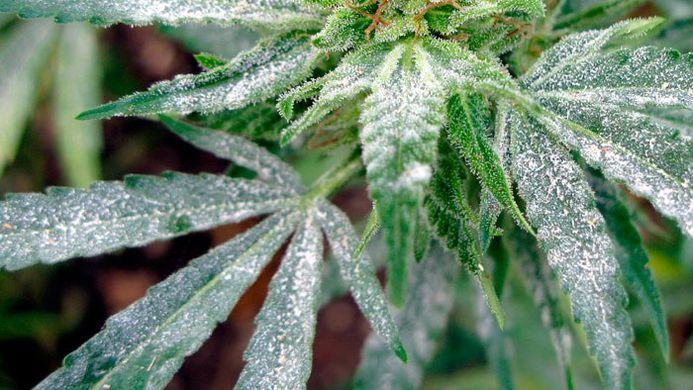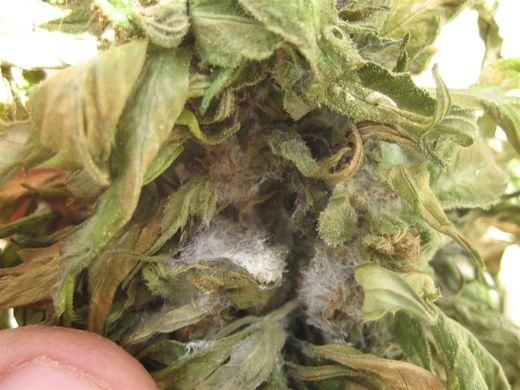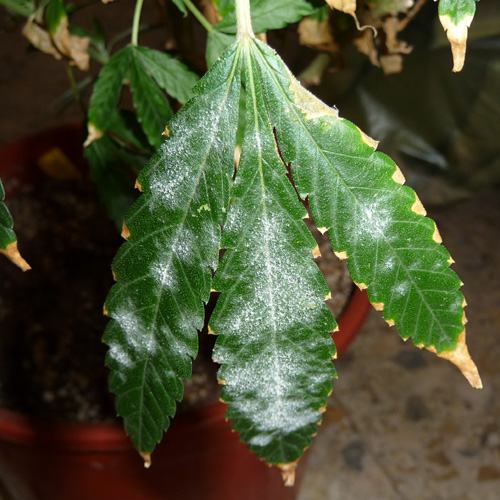Summer is here, heat, humidity ... and fungi, enchanted by the combination of all these factors, come to our marijuana crop. So, although in outdoor cultivation it is more difficult to control temperature and humidity than in indoor cultivation, let's review why we can have fungi and how we can treat them.

Photography from Cannabislandia
Fungi, the microscopic plague: Botrytis, Powdery mildew, Downy mildew and Fusarium
There are many types of fungi, but we will focus on the ones that we can find most frequently to know how to detect them and what to do to stop them and eliminate them from our marijuana crop . Unlike other insect pests , fungi are microscopic and We can only realize it once we see the first signs of the evil they are doing.
BOTRYTIS
Botrytis is the most common fungal pest that you can find in cannabis cultivation. It is favored by temperatures between 15 and 25ºC, poor ventilation and high humidity . Drastic changes in temperature between night and day, for example, easily generate this humidity. It spreads very quickly, for days and even hours. Pay attention to it because it is very hard to lose months of work in your crop at a time, especially at this time of year.
Symptoms
Botrytis is very easy to detect quickly as it appears as gray mold . In fact, this mushroom is also popularly called that same way. We will see necrosis in stems and leaves. The fabric of the leaf changes color and texture. It rusts, rots, dries, degrades and we will see spots of a brown and grayish appearance. We can also see how it takes that typical mold hairiness. We can find it above all in the buds , it dries them, they remain as granules and mold appears with a cotton appearance on the inside.
How to fight it
Humidity is the main cause that fuels this pest, so we must ventilate the growing area well to reduce humidity . If we have had an infestation of caterpillars, surely you are going to have numbers of having botrytis, since the tiny excrements that the caterpillar leaves in its path, can generate this type of fungus. After removing the caterpillars, pay attention to the signs and try to prevent it at all costs. If your cannabis plant is suffering from botrytis, the first thing to do It is to cut the entire infected area , even a little more in case there are microscopic infected particles that are already being spreading. After cleaning the plant, disinfect the growing area and the tools that have been in contact well to avoid debris. It is even advisable to prune a few more leaves, precisely to that this humidity does not accumulate and the air runs between the plant. You can go to fungicides although it does not guarantee that it will eliminate them, and you will be leaving chemical remains. You can also try organic fungicides such as propolis or horsetail to prevent it.

Photography by Greencultured
EARNESS
Symptoms
This fungus is also easy to spot. It leaves a layer of gray powder or whitish, like ash. We will see gray or white spots that begin to appear on the leaves and if we do not stop it, it continues on the stem and buds. When removing the dust, we will see how that yellow part remains, since it does not allow photosynthesis to be carried out correctly.
How to fight it
Powdery mildew appears from 20ºC, high humidity and drastic temperature changes, so we can play with these values to keep it at bay: lower the temperature, if you have indoor cultivation, reduce humidity, ventilate the space, etc. One of the biological components that works for this pathogenic fungus is Thricoderma Hanzianum , which is often used to plant and precisely prevent this type of fungus. On a preventive level, we have other biological products such as horsetail or propolis . Although yes We already have the plague on us and there is no way to eliminate it, as long as we are within the safety period in the phase of our cannabis plant, we can go to spray chemical fungicides that contain elements such as cyproconazole, tetraconazole or Triadimenol, which are usually very effective against powdery mildew.
 Photograph by CultivandoCannabis
Photograph by CultivandoCannabis
MILDIU
Mildew is similar to powdery mildew and we could easily mistake it. Just as powdery mildew appears on the upper part of the leaf, mildew usually originates on the reverse side, although we will surely see its signs above the leaf where yellowish and translucent spots appear, as if it were oil .
Symptoms
These are usually greasy marks that can be seen around the edges of the marijuana leaf, which turns yellow and brown, dries and rots . Under the leaf is where that white powder similar to powdery mildew could appear.
How to fight it
As in the previous fungal pests that we have mentioned, it also appears due to humidity, moderate temperatures between 15 and 25ºC. Mildew can infiltrate the wounds of the plant through irrigation and appear after the rains . Balancing these values will help us prevent it as well as propolis , horsetail and Bordeaux mixture .

Photography by Fumatinga
FUSARIUM
Fusarium is a fungus that lives in the substrate . It blocks the vessels, blocking the passage of sap and nutrients. This causes the marijuana plant to wilt and rot.
Symptoms
We will see how the older leaves rot quickly and the stems rot from the base , and we will see that the interior of the stem takes a brown and even reddish in color.
How to fight it
Like other mushrooms, the 3 elements of temperature, humidity and ventilation are basic. It can also be caused by having few hours of light. From there, one of the most effective biological preventives is Trichoderma, which we must apply to the substrate of the pot and not use other chemicals that would eliminate it. Something that we must also take into account is not to go overboard with fertilizers since an excess of nitrogen, for example, would lead to fusarium which is then very difficult to eliminate and will almost force us to discard the entire plant if it becomes very infected. The worst thing about this fungus is that it rots the base of the stem and that will make it difficult to recover our marijuana plant. As we discussed earlier, it is also important to clean the entire growing area and the tools that have been in contact so as not to infect the crop.
